The chapel windows are based on 15th century Flemish styles and make generous use of the color blue, the traditional color of the Virgin Mary. With their brilliant colors and clear images, the windows hold their own amid the elaborate sculptural decoration of the chapel.
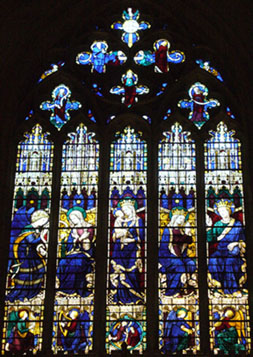
Altar Window
The altar window consists of five panels, divided horizontally by a transom. Amid the stone tracery (near the top) are three figures. In the center section is the prophet Hosea with the verse: “I draw them with cords of a man [i.e., human kindness], with bands of love” (Hosea 11:4). The sections to his left and right show the two most-venerated Roman Sibyls, bearing their prophecies that were taken to refer to the birth of Christ. Capitalizing on the religious influence of the ten prophetic sibyls of the classical world, second century BCE. Alexandrian Jews composed verses in the same form, attributed them to the sibyls, and circulated them in order to diffuse Jewish teaching. Second and third century Christians adopted the same practice, and the Sibyls are quoted frequently by early Christian writers, who saw them as bridges between the Greek and Roman world and the Christian era. Here, to the left is the Sibyl of Erythraea bearing the legend Humanabitur proles divina, jacebit in feno agnus (The divine offspring shall become human, the lamb shall lie in the straw.). To the right is the Sibyl of Cumae bearing the legend Jam nova progenies celo dimittitur alto (Now from high heaven the new offspring is sent forth.).
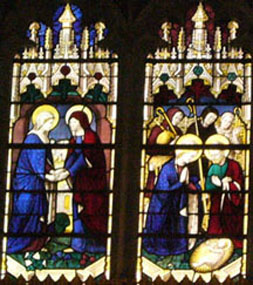
Visitation of the Virgin Mary to Elizabeth & Adoration of the Shepherds
The middle row consists of two sections, with the prophet Isaiah on the left with the verse “Behold, a virgin shall conceive, and bear a son” (Isaiah 7:14) and the prophet Micah on the right with the verse “Out of thee shall he come forth … that is to be ruler in Israel” (Micah 5:2). Spanning the two sections, two angels hold a scroll with the continuation of Isaiah’s verse in Matthew’s gospel, “And they shall call his name Emmanuel, which, being interpreted, is God with us” (Matthew 1:23).
The lower sections show scenes related to the birth of Jesus: the Visitation of the Virgin Mary to Elizabeth (Luke 1:39-56), the Adoration of the Shepherds (Luke 2:8-18), the Adoration of the Three Kings (Matthew 2:1-12), and the Flight into Egypt (Matthew 2:13-21).
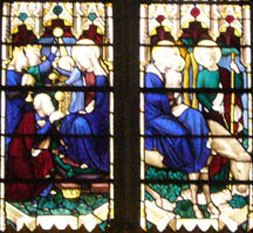
Adoration of the Wise Men & Flight into Egypt
The center section is of solid stone, setting off the central gilded canopy of the altar screen which rises in front of it. Beneath each of the four left and right sections is an angel playing a musical instrument.

Virgin & Child above Joseph’s Dream
Above the transom, in the large central light stands the Virgin and Child with a roundel beneath showing St. Joseph’s dream in which the angel told him “his name shall be called Jesus” (Matthew1:21).
The two large lights to the left show the angel Gabriel’s Annunciation to Mary (Luke 1:42-38).
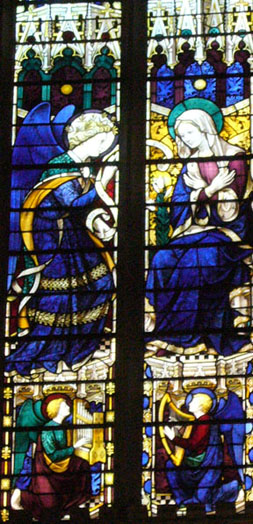
Annunciation with Archangel Gabriel & the Virgin Mary
The two large lights to the right show the legendary Coronation of the Virgin.
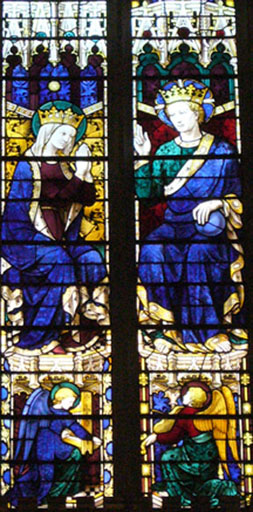
Coronation of the Virgin
The two side windows in the right (east) wall at the back of the chapel are each
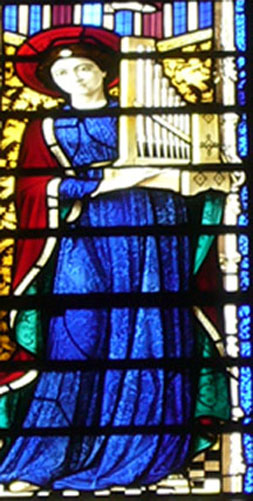
St. Cecilia with face of Leslie Lindsey
composed of two lights. The left window represents Cecilia of Rome, patron of music (her face a glowing portrait of Leslie Lindsey Mason, herself a singer), holding a reed organ and attended by an angel.
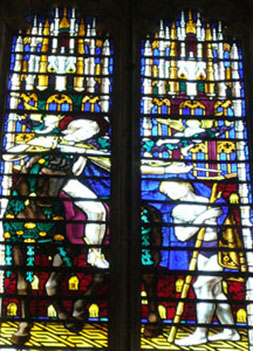
St. Martin of Tours
The right window represents Martin of Tours, patron of philanthropy (his face a portrait of Stewart Southam Mason), sharing his cloak with a beggar.
Martin of Tours (316-397) was a conscripted soldier who sliced his military cloak in two and gave half to an unclothed beggar in bitterly cold weather. That night he dreamed of Jesus wrapped in the half-cloak. A catechumen at the time, he immediately asked for baptism, became a conscientious objector, and was briefly imprisoned until a general amnesty was declared. He long refused ordination to the deaconate, but was eventually persuaded to serve as Bishop of Tours (371-397) while living privately as a monk.
William Lindsey used the story of Martin of Tours as the signature theme of his novel The Severed Mantle (1909), in which a 12th-century troubadour, inspired by Martin’s story, slices his cloak in half and vows to “wear a severed mantle all my life” as a pledge of purity and love. Eventually he becomes a knight as well and learns that human and divine love are complementary.
The entrance window is composed of five lights (panels) and has as its theme the Bride of the Apocalypse.
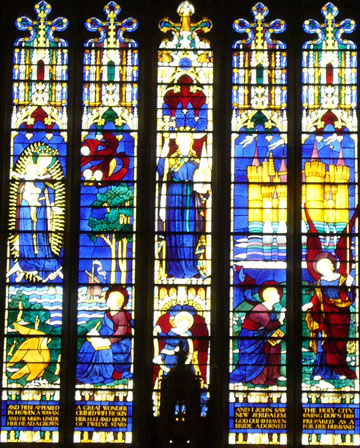
Bride of the Apocalypse
In the central light is the figure of the Church as a bride, with an angel below bearing the legend from the Nicene Creed: Credo in unam Sanctam Catholicam et Apostolicam ecclesiam (“I believe in one Holy Catholic and Apostolic Church”).
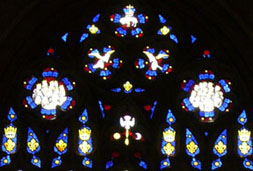
Heavenly Worship
The lights amid the stone bar tracery above depict the apocalyptic description of Heavenly Worship, with “the Lamb as it had been slain” (Revelation 5:6) at the top, two lights in the middle depicting angels, and two lights at the bottom of the tracery, each with 12 elders, representing the “four and twenty elders sitting, clothed in white raiment; and they had on their heads crowns of gold” (Revelation 4:4).
The two lights to the left depict the Heavenly Woman described in the legend beneath them: “And there appeared a great wonder in heaven; a woman clothed with the sun, and the moon under her feet, and upon her head a crown of twelve stars” (Revelation 12:1).
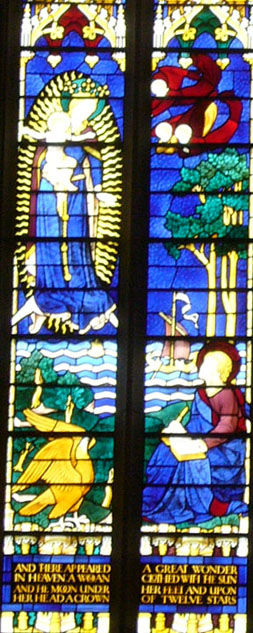
Revelation to John
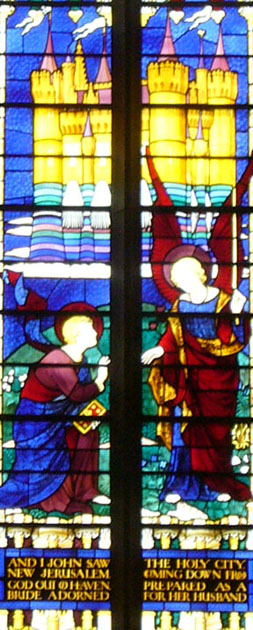
The New Jerusalem
The two lights to the right represent the apostle John’s vision of the New Jerusalem described in the passage below it: “I John saw the holy city, new Jerusalem, coming down from God out of heaven, prepared as a bride adorned for her husband” (Revelation 21:2). John is depicted kneeling, attended by a standing angel.

